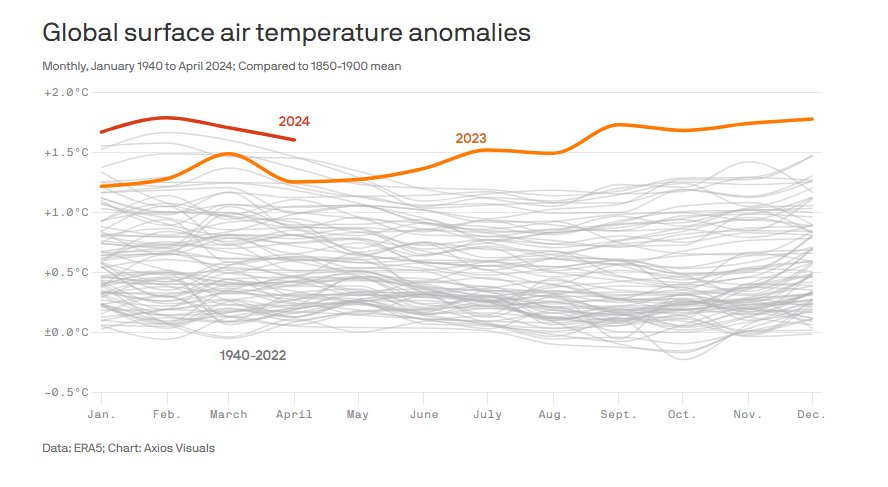It certainly didn’t take long for climatologists to pronounce the year 2023 as the hottest year ever recorded for our planet. On January 1st the World Meteorological Organization (WMO) immediately declared that not only had 2023 broken all previous temperature records but that it had done so by an unprecedented amount. Many scientists blamed the record shattering heat on a combination of global warming with a particularly strong El Nino in the Pacific but many others felt that there had to be additional factors at work as well.

And so far 2024 hasn’t been any better, the global heat wave has continued with January being the hottest January ever recorded followed by February being the hottest February ever then March and so far April. Even worse, the world’s oceans are also setting records for the hottest temperatures ever measured, and remember it takes a lot more heat, more energy to heat up water than it does to warm up air.


In fact the WMO’s annual State of the Climate Report, which was issued on the 19th of March, gave special significance to the rising temperatures in the world’s oceans claiming the measured increases were “Off the Charts”. So huge is the amount of heat now entering the oceans that it may take centuries for them to return to pre-industrial temperatures, even after the elimination of greenhouse gas emissions. In other words, even if we ended all greenhouse gas emissions today, the world’s oceans might take several hundred years to fully cool back down.

And the long term consequences of the warming of the oceans is only now becoming understood. A new study published in the journal Frontiers in Marine Science and led by Alexey Mishonov of the University of Maryland’s Earth System Science Interdisciplinary Center (ESSIC) has complied decades of data on conditions in the Atlantic Meridional Overturning Circulation (AMOC). That’s the system of ocean circulations in the north Atlantic that includes the well known Gulf Stream.

What the researchers found was that the current flows of the system remained stable during the period from 1955 to 1995, but from 1995 onward all of the currents have weakened measurably. This weakening of the circulation is attributed to both the increased temperatures at the ocean’s surface but also to a decrease in salinity caused by the melting of the polar icecaps as well as the Greenland ice sheets. These scenarios were used as the main plotline in the 2004 movie ‘The Day after Tomorrow’ and while the timescale of that movie was several orders of magnitude too fast the consequences, and the climate damage they would cause, are quite within the realm of possibility.

Worst still, another study has detailed the effects of sea level rise on the US east and Gulf coasts. The paper, which was published on March 6th in the journal Nature, used satellite images to show that not only are sea levels rising but that the land right along the coasts from Maine all the way around to Texas are sinking. The combination of these two factors is putting the homes and businesses of millions of Americans at risk of being swept away in the next major storm.

According to the study there are many reasons for the subsidence of the land, most of them related to human activity. In Louisiana and eastern Texas the pumping out of oil and natural gas from the ground is the leading cause but in Charlestown South Carolina and Atlantic City New Jersey it’s the pumping out of groundwater to use as drinking and household water that is causing the land to sink. Regardless of the cause many very expensive beachfront homes must now either be protected by very expensive dykes and breakwaters, or simply abandoned to the ocean.

Finally one more small item dealing with climate change. The ever increasing temperatures around the globe obviously includes the world’s wine growing regions as well. For centuries different parts of the globe, like Italy or Spain, grew grapes that were acclimated to the heat of the country they grew in while other regions like The Rhineland in Germany or Burgundy in France, grew grapes that liked weather that was a bit cooler.

Well thanks to global warming that’s all changing with Germany and France now getting as hot as Italy and Spain were while Italy and Spain are just getting too hot. One consequence of the increased heat might sound at first like a good thing, the grapes are producing more sugar and after fermentation that means more alcohol. Wine experts however say that the wines no longer taste the same, the increase in strength is taking away something of the complex flavour of many varieties of wine.

Now what is bad for some parts of the world, Italy, Spain and southern California, could actually be good for places that are not generally thought of as wine producing areas like the UK or New England. At the same time places like Germany or France may need to change the types of wines they grow to reflect that their climate is now more like the way Italy and Spain used to be.

Just one more way that climate change is forcing entire industries to make major changes to the way they do business. All just so the petroleum companies can continue to make their unholy profits.
